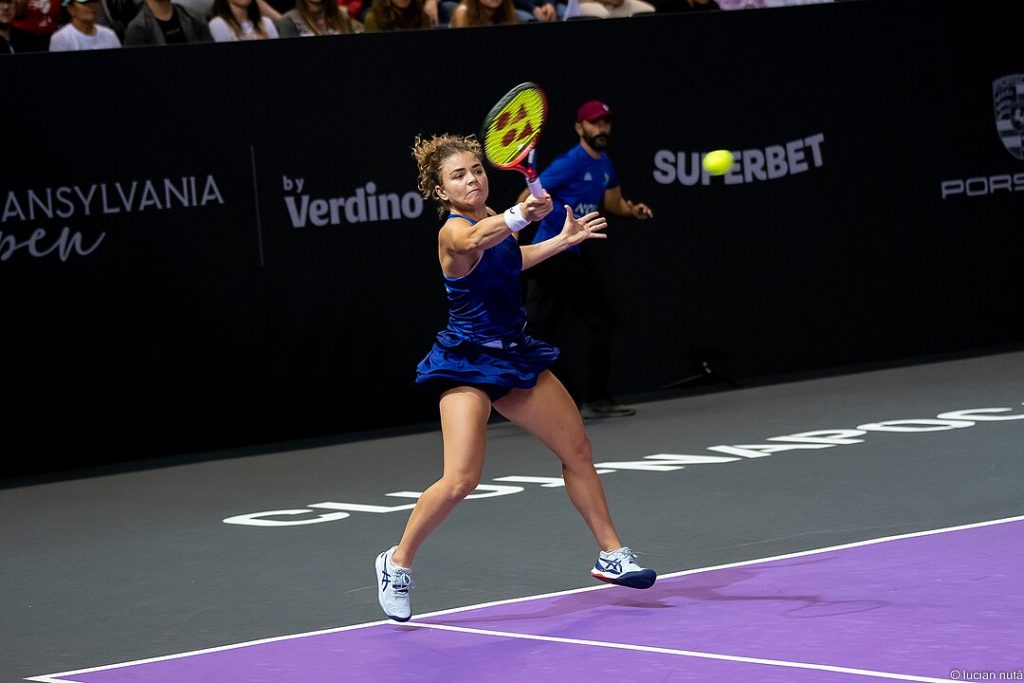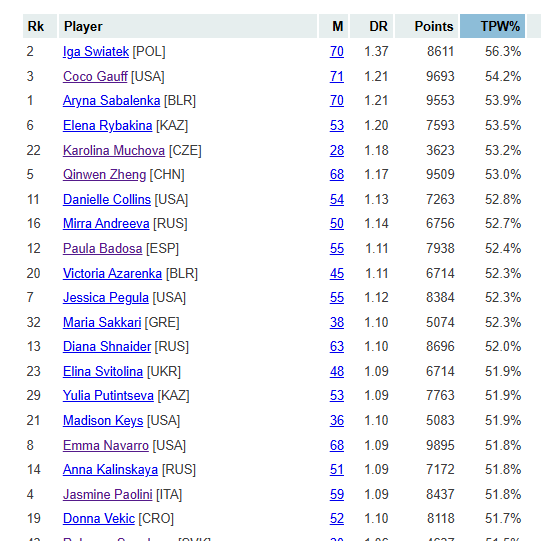
There are unorthodox aging curves, and then there’s whatever the hell Jasmine Paolini is doing right now. The best women tennis players tend to make their presence known in their late teens. I wrote earlier this year about the “improbable rise” of 22-year-old Emma Navarro.
Paolini is 28.
When Paolini was the age that Coco Gauff is now, she was ranked just inside the top 300, fresh off a first-round loss at an ITF $25K in Bulgaria. When she was the age that Iga Swiatek is now, she had finally cracked the top 150, about to head to Wimbledon qualifying. (She lost in the first round there, too.) When she was the age that Aryna Sabalenka is now, she had just stumbled through a four-match losing streak to the likes of Jil Teichmann and Irina-Camelia Begu that knocked her out of the top 50.
Just 16 months ago, Paolini was once again outside the top 50. For a five-foot, four-inch counterpuncher with no obvious weapons, she had achieved a great deal. There was little reason, though, to think she could climb much higher. Her peers were getting bigger, the game was becoming ever more aggressive, and she was reaching the age at which WTA stars begin to think about what else life might hold for them.
Then she started winning.
Since leaving Wimbledon last year, the Italian has won 66 of 99 matches, including two major semi-finals and five top-ten scalps. She picked up her first 1000-level title and made four other finals. Yesterday, she led Team Italy to a Billie Jean King Cup crown, starring in both singles and doubles en route to the championship. Her ranking is up to an astonishing 4th in the world. As if that weren’t enough, she’s in the top ten in doubles.
None of this was supposed to happen. Paolini’s late-2023 surge to the top 30 was one thing; what has happened since simply defies belief. How has she managed it? Is it a fluke, or will we see the Italian at the 2025 year-end championships as well?
Opportunistic effects
First, a bit of a caveat. Paolini, like Taylor Fritz, has played the official ranking system like a Stradivarius. She reached only three finals in 2024, yet two of them were slams. The other was a 1000. She earned huge chunks of points for a semi-final defeat of Mirra Andreeva at Roland Garros, a semi-final squeaker against Donna Vekic at Wimbledon, and a Dubai title that didn’t require her to face a top-ten opponent.
None of this is meant to take away from Paolini’s accomplishment. She beat the players in front of her, and in the case of Andreeva, she did so in emphatic fashion. The point is that her top-four finish has more to do with good timing than consistently dominant play.
My Elo ratings offer a second opinion, using an algorithm based on the quality of her opponents, rather than the venue and round of each match. By Elo, she stands in 9th place, just ahead of Madison Keys and Diana Shnaider, well back of Jessica Pegula and Elena Rybakina. Still a very good season, if a bit less astounding.
Even more revisionist is the total-points-won leaderboard. Going into the BJK Cup Finals, Paolini had won 51.8% of her total points this season. That’s a respectable rate, especially for someone who hovered in the 50% range for most of her tour-level career. But it is not typically top-five, or even top-ten material:

By this metric, the Italian stands in 19th place among the WTA top 50, behind a handful of players who didn’t even crack the official top 20. That doesn’t really mean she’s the 19th best player on tour: She faced one of the toughest schedules of anyone. Much as I love both Yulia Putintseva and counterintuitive arguments, I’m not going to try to convince you that Putintseva had the better season.
Still, Paolini’s position on the TPW list tells us something about how she won her matches. She didn’t lose many blowouts, but she didn’t win many, either. (She certainly didn’t get in the habit of spanking opponents like Swiatek and Sabalenka do.) Ten of her wins required a third set. Two victories–including the Wimbledon semi-final–came despite losing more points than she won.
The margins were not so narrow that we can ascribe the Italian’s breakout to luck. (Though the Vekic match could have gone either way, to say the least.) But this is the high-wire act that took Paolini to the top. She doesn’t have the tools to bludgeon her opponents. She has done a lot of things right to win 42 matches this year. To keep winning at a two-of-three clip, she’ll need to continue executing the new game plan to near-perfection.
The new game plan
It’s a bit tricky to isolate the key changes in Paolini’s approach, because–like Qinwen Zheng–she’s doing almost everything better than she did before the surge. That said, a few things stand out.
Check out the Italian’s breakdown of points won by rally length (in Match Charting Project-logged matches) before this season, compared with her performance this year:
Span 1-3 W% 4-6 W% 7-9 W% 10+ W% 2016-23 49.1% 46.5% 51.0% 49.4% 2024 49.8% 54.3% 56.6% 49.1%
Paolini’s improvement in 7- to 9-stroke rallies is significant, and her gain in the 4- to 6-shot category is enormous. In very short points and very long ones, little has changed.
Especially in the categories of shorter points, we need to keep in mind what these win rates measure. It’s tempting to think of a prototypical short point, then imagine Paolini, instead of her opponent, winning it. But the length of a given point is not handed down to us by God. When someone like Paolini starts winning more shorter points, it’s because she is ending them before they become long points, and/or she is preventing her opponents from ending points quickly.
The Italian can hardly stack up one-shot points (unreturned serves), and she can’t even reliably put away plus-ones–though she is doing that more than she used to. Instead, like the expert doubles player she has become, she can structure points that inch closer and closer to a point-ending opportunity. Call it plus-two tennis, aggressive point construction for undersized counterpunchers.
The plus-two forehand
Tactics are one thing; Paolini is a top-ten player because she has executed them so well. Her forehand is a big reason why.
She is ending points with her forehand at a much better clip than she did before the calendar flipped to 2024, and her inside-out forehand has seen particular improvement:
Span FH Wnr% DTL Wnr% IO Wnr% FHP/100 2016-23 11.7% 17.7% 6.2% 2.9 2024 17.5% 25.2% 13.3% 10.2
Here, “winners” refer to both clean winners and shots that induce forced errors. Through 2023, Paolini’s forehand winner/forced error rate of less than 12% put her in the bottom quarter of tour regulars. 17.5% moves her to the top third, not far behind Swiatek and Keys. The same stat for inside-out forehands (IO Wnr%) doesn’t put her in quite the same company, but it is an even better reflection of the tactical shift. Before, the Italian rarely used that shot as an offensive weapon; now it is a regular part of the arsenal.
The bottom line is reflected in the Forehand Potency (FHP/100) numbers. The number of points Paolini earns with her forehand more than tripled from previous seasons to 2024. That doesn’t quite account for the entire shift from a top-50 player to a top-fiver, but it explains a whole lot.
And the no-fearhand
One side effect of the Italian’s forehand-centered strategy is that she is less afraid of other players’ forehands.
Again, Paolini is doing just about everything better. For instance, 22% of her first serves went unreturned in 2024, compared with 20% in the past. Nice little boost, but not something you would notice by watching a couple of matches. A bigger shift is where she puts the first serves:
Span 1st Unret% <=3 W% RiP W% D Wide% A Wide% 2016-23 20.2% 28.1% 48.3% 25.0% 45.7% 2024 21.8% 34.8% 53.4% 37.4% 44.8%
Check out the rate at which she is hitting deuce-court first serves wide (D Wide%). 25% to 37% is a massive change, and one that would be dangerous for a different sort of player. In the deuce court, the down-the-tee serve is the conservative one: It goes to the backhand of a right-handed returner, and since it lands in the middle of the court, the returner doesn't have any sharp angles to exploit. The wide serve is the opposite, feeding forehands to opponents like Sabalenka, Rybakina, or Zheng along with the angles necessary to turn them into winners.
What Paolini knows--again, like a savvy doubles player--is that most players will fail to convert the majority of those opportunities, even if they occasionally smack a highlight-reel return winner. The Italian didn't crack the top five by running the table against the elite. Most of her 42 wins came against the next rung of competitors, women who are often held back by inconsistency. Paolini pushed them off the court, giving the choice of either going big (and frequently missing), or sending back a shot that she could handle with her own (improved!) forehand.
All those deuce-court wide serves explain how Paolini picked up so many more plus-one winners (the <=3 W% column) and converted so many in-play returns overall (RiP W%). Every individual wide serve is a gamble, but the Italian has discovered that, on net, they pay off.
The way forward
I'm a bit surprised to find myself concluding that, yes, Paolini might just maintain this level. The odds are heavily against another top-five finish. That was a quirk of her draws and well-timed (probably accidental!) peaks. But 52% of total points? A single-digit year-end ranking? Maybe!
Once I began thinking of the Italian's singles play in terms of doubles strategy, it all clicked. Her anticipation is outstanding--and like everything else, it is better than it was last year. She often wins points without working particularly hard. She's in the right place to end the point on the fifth or sixth shot of the rally. (That place is increasingly at the net. She came to net more in 2024, and she won more of those points than before, too.) Anticipation isn't a skill that will deteriorate with age, nor is it one that opponents can neutralize.
Paolini's new point-shortening, forehand-smacking, deuce-court-serving tactics aren't going to earn her many big upsets, just as they haven't so far. The strongest players--not coincidentally, often the ones with the most fearsome forehands--are the ones in the best position to take advantage the wide deuce-court serves and force the Italian both to move off the baseline and rely more on the backhand.
But a top-ten season doesn't require a pile of top-ten victories. Paolini was 3-6 against that group this year, and that included one win against a fading Ons Jabeur and another in Riyadh against a rusty Rybakina. The Italian's finish owed much more to her 38-15 record against everyone else. Despite the improbability of a top-ten debut at age 28, Paolini has built a game capable of repeating the feat in 2025.
* *
Subscribe to the blog to receive each new post by email: